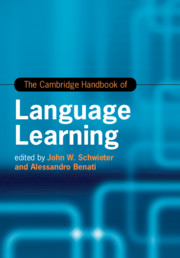Book contents
- The Cambridge Handbook of Language Learning
- Cambridge Handbooks in Language and Linguistics
- The Cambridge Handbook of Language Learning
- Copyright page
- Contents
- Figures
- Tables
- Contributors
- Acknowledgements
- Introduction
- Part I Theories
- Part II Methods
- Part III Skill Development
- Part IV Individual Differences
- Part V Pedagogical Interventions and Approaches
- Part VI Context and Environment
- 27 Bilingual Education and Policy
- 28 Heritage Language Instruction
- 29 Minority Languages at Home and Abroad: Education and Acculturation
- 30 Study Abroad and Immersion
- 31 Teacher Education: Past, Present, and Future
- Part VII Moving Forward
- Index
- References
30 - Study Abroad and Immersion
from Part VI - Context and Environment
Published online by Cambridge University Press: 25 June 2019
- The Cambridge Handbook of Language Learning
- Cambridge Handbooks in Language and Linguistics
- The Cambridge Handbook of Language Learning
- Copyright page
- Contents
- Figures
- Tables
- Contributors
- Acknowledgements
- Introduction
- Part I Theories
- Part II Methods
- Part III Skill Development
- Part IV Individual Differences
- Part V Pedagogical Interventions and Approaches
- Part VI Context and Environment
- 27 Bilingual Education and Policy
- 28 Heritage Language Instruction
- 29 Minority Languages at Home and Abroad: Education and Acculturation
- 30 Study Abroad and Immersion
- 31 Teacher Education: Past, Present, and Future
- Part VII Moving Forward
- Index
- References
Summary
Intuition tells us that immersion in a host speech community offers second language (L2) learners the best opportunity to enhance their L2 proficiency, intercultural competence, and global-mindedness. While some study abroad (SA) participants experience gains in all of these areas, contemporary researchers are finding that learner outcomes are highly variable. Not only are there significant differences among SA programmes, but a complicated mix of a variety of environmental elements including individual differences can affect the developmental trajectories of students participating in SA programmes. Even when two language learners with similar characteristics (e.g., language proficiency, intercultural competence, international experience) join the same study abroad programme, their development and outcomes may differ greatly. Students develop intercultural competence and L2 competence with idiosyncratic tendencies, which makes this topic valuable for researchers to investigate.
- Type
- Chapter
- Information
- The Cambridge Handbook of Language Learning , pp. 727 - 750Publisher: Cambridge University PressPrint publication year: 2019
References
- 2
- Cited by

